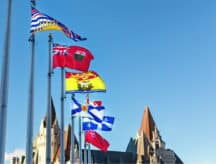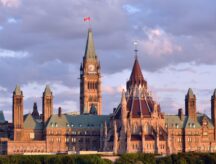Second Quarter of 2017 Sets New Express Entry Records
While 2017 has already been statistically the biggest year ever for Canada’s Express Entry immigration selection system, no quarter has seen a higher number of candidates invited to apply for Canadian permanent residence than the second quarter of 2017. Along with this increase, the second quarter of 2017 also saw the number of Comprehensive Ranking System (CRS) points required in order for a candidate to be issued an Invitation to Apply (ITA) reach a record new low.
In addition, the spring and early summer period was a time in which Immigration, Refugees and Citizenship Canada (IRCC) created new opportunities for candidates in the Express Entry to be awarded additional points. IRCC also devised innovative new strategies to invite certain candidates through program-specific draws.
All of this activity followed a first quarter during which the number of ITAs being issued shot up, which in turn was a contributing factor to a decrease in the CRS cut-off threshold. One record-setting quarter has been followed by another, giving Express Entry candidates cause for optimism through the second half of the year and beyond.
April, May and June a busy period
The 26,653 ITAs issued during the second quarter of 2017 was more than the 24,632 ITAs over the first quarter, and more than double the 13,202 issued over the course of the final three months of 2016.
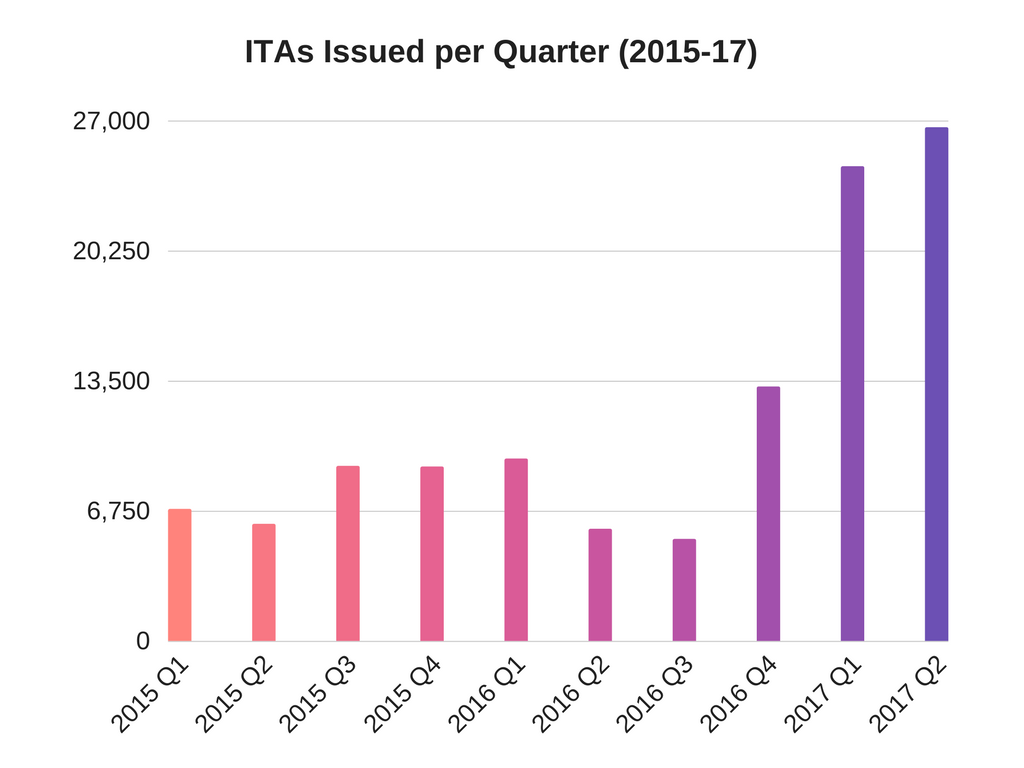
During the second quarters of 2015 and 2016, a total of 5,821 and 6,077 ITAs were issued, respectively.
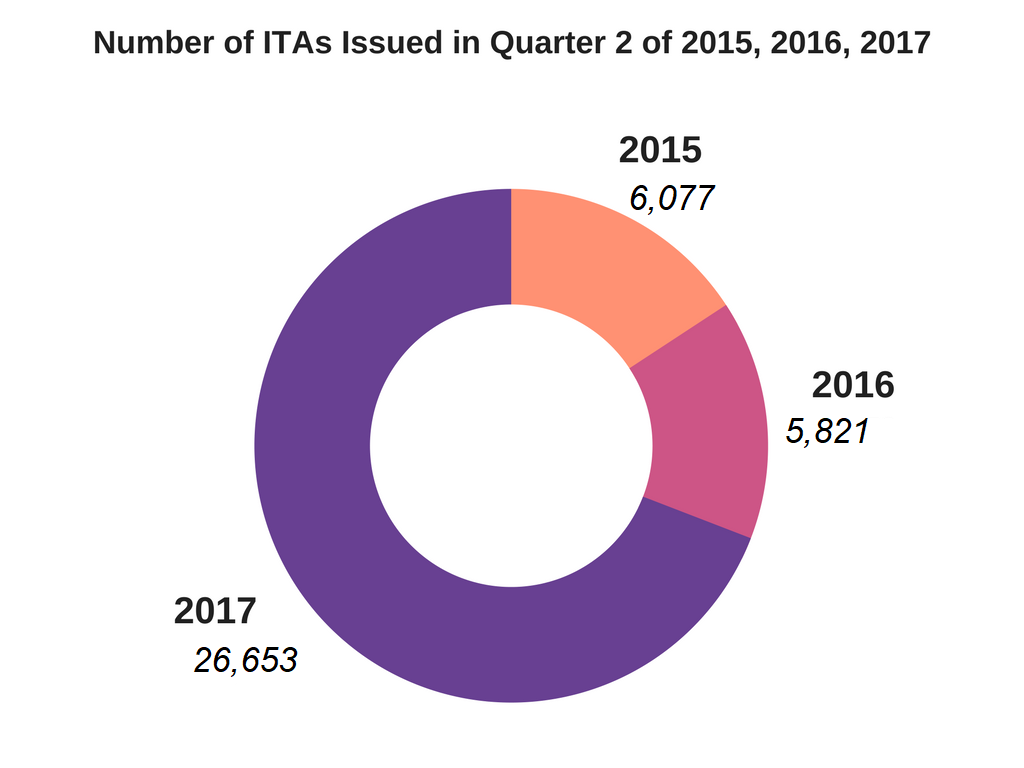
The effect on CRS thresholds
There were nine Express Entry draws conducted over the second quarter of 2017, four of which set new record lows for the minimum CRS required.
As was the case in the early months of the year, the increase in ITAs from April through to June was a large contributing factor in the decrease in the CRS threshold. This threshold went down to as low as 413 on May 31 for candidates in the pool eligible under Federal Skilled Worker Class (FSWC) or Canadian Experience Class (CEC).
Just a few days previously, on May 26, IRCC performed two program-specific draws from the pool. The biggest beneficiaries on that occasion were candidates in the pool under the Federal Skilled Trades Class (FSWC) — FSWC candidates with CRS scores as low as 199 were invited to apply.
The graph below indicates draw the CRS cut-off thresholds over the course of 2017, with the second quarter highlighted.
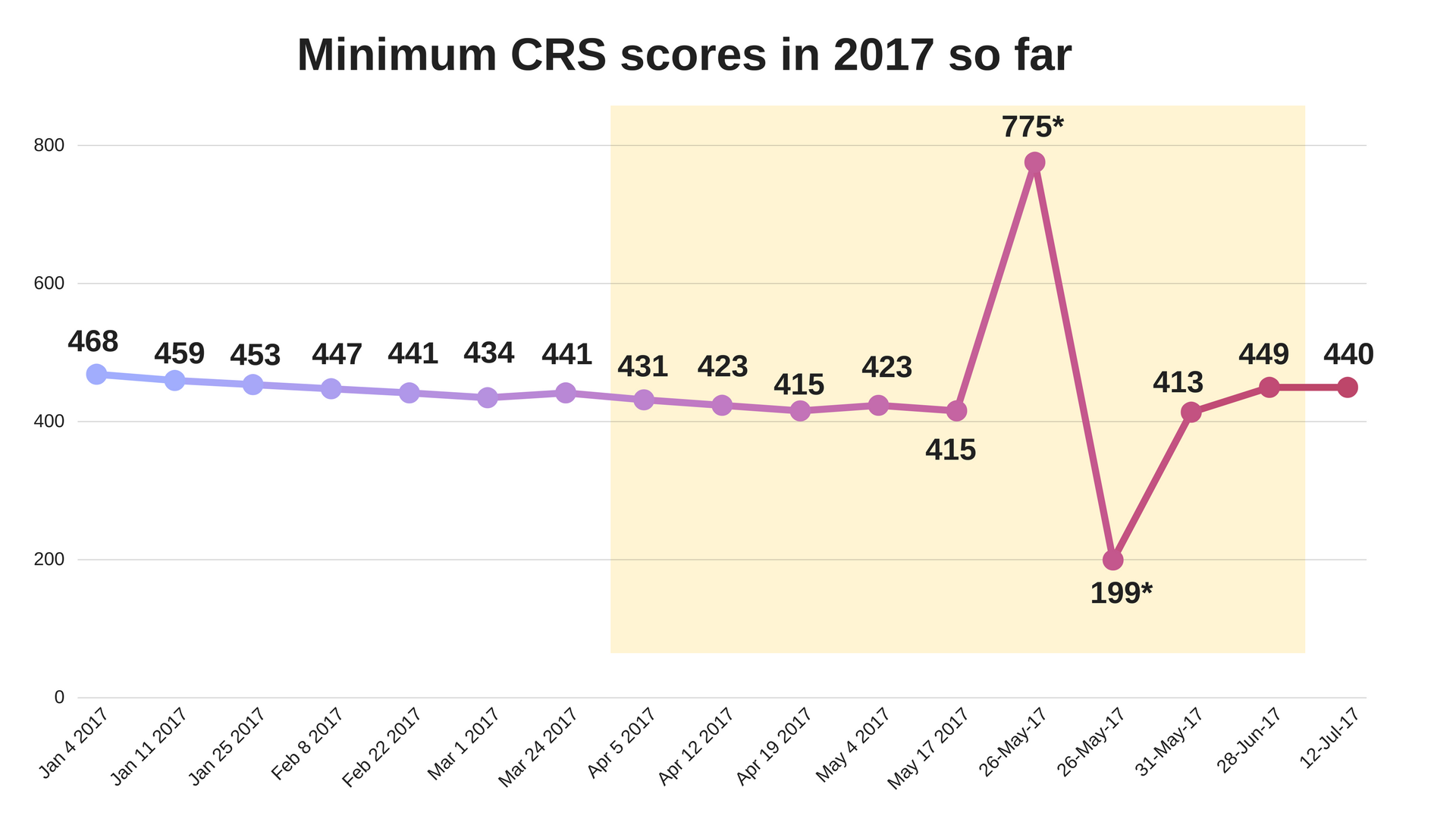
What about candidates with lower scores?
Many candidates who entered the pool with CRS scores below the minimum drawn were able to raise their scores and obtain ITAs. This was shown over the course of 2016, when more than half (55 percent) of candidates who received an ITA had core CRS scores below 450 (the lowest score drawn in 2016). Core CRS indicated a candidate’s score without the additional points for a provincial nomination, a job offer, or post-secondary education obtained in Canada.
Since 2016, new additional points factors have been introduced for candidates with a sibling in Canada and for candidates with French ability. With these new factors, the range of possible ways to increase one’s score has expanded.
The most valuable single factor under the CRS is a provincial nomination, which is worth 600 CRS points; therefore, a candidate with a CRS score of 200 would become a candidate with a score of 800 as soon as he or she obtains a provincial nomination. With this nomination, a candidate will receive an ITA at a subsequent draw from the pool.
Most Canadian provinces dedicate a portion of their Provincial Nominee Programs (PNPs) to select candidates in the Express Entry pool. As we move deeper into 2017, provinces are coming up with pioneering new strategies to welcome newcomers from the Express Entry pool.
The provincial factor
As the federal government has made Express Entry the main driver of economic immigration to Canada, many provincial governments have made their ‘enhanced’ Express Entry-aligned PNP streams a significant driver of immigration to the provinces.
For example, over recent weeks and months the provinces of Ontario, Nova Scotia, Saskatchewan, and British Columbia (BC) have been particularly active with their enhanced PNP streams.
In Ontario, a new approach introduced in the final week of June allowed Ontario Immigrant Nominee Program (OINP) officials to search the Express Entry pool for candidates with experience in an Information Technology (IT) occupation, with a view of selecting applicants for the Express Entry-aligned OINP Human Capital Priorities stream. Candidates with experience in certain IT occupations were prioritized for selection, even if they scored less than 400 points under the Comprehensive Ranking System (CRS). Normally, Ontario only invites candidates with 400 or more CRS points. This strategy may be repeated, either for IT professionals or with other candidates in mind.
In Nova Scotia, the Nova Scotia Demand: Express Entry stream reopened on July 5 for Express Entry candidates in one of 16 target occupations, including occupations in finance, health care, engineering, information technology, academia, social work, and law. The intake period closed within hours, showing not just the enduring popularity of this stream, but also the need for candidates to be prepared to apply at a moment’s notice as no prior warning in given for the stream reopening. No job offer is required under this stream.
As in the case of Nova Scotia, Saskatchewan’s International Skilled Worker – Express Entry sub-category also seeks out candidates in certain occupations, and no job offer is required for eligibility. In Saskatchewan’s case, 17 occupations are considered in demand (indeed, civil engineers are on both the Saskatchewan and Nova Scotia list). The mid-May intake period for the Saskatchewan program lasted just over a week, which was actually longer than many previous intake periods. This sub-category of the Saskatchewan Immigrant Nominee Program (SINP) has opened three times so far this year, and may do so again.
BC has also joined the ever-growing clutch of provinces looking for IT/tech professionals in the pool. The arrival of tech-only draws through the British Columbia Provincial Nominee Program (BC PNP), a new strategy for immigration to BC, was announced after six such draws had taken place from May through to July. BC also continues to invite workers and graduates in non-tech occupations.
What does the future hold?
It should be noted that the current record low CRS cut-off threshold of 413 came in the May 31 draw. That draw was then followed by four weeks without a draw, as IRCC implemented its new additional points factors and updated the pool accordingly. In many cases draws occur every two weeks, or even more often.
“Because of the four-week pause in draws, we never really got to see how low the CRS threshold may have gone if the usual two-to-three draws per month routine had continued without pause. During the pause new candidates joined the pool, some candidates got a boost in scores because of the new factors, and more candidates may have been able to upload a provincial nomination to their profile — all of which meant that the threshold increased temporarily before beginning to come down again,” notes Attorney David Cohen.
“It is also clear, however, that more provinces are engaging with Express Entry in innovative ways, and that draw sizes remain large. Moreover, with a high immigration target for next year and plenty of scope for IRCC to invite candidates through the second half of 2017, it is likely that candidates from different backgrounds and in a variety of occupations and scenarios will continue to benefit.”
The CRS Calculator
Readers can use the new and improved CRS Calculator to find out what their score would be under the updated system.
To find out if you are eligible to immigrate to Canada permanently, fill out a free online assessment form.
© 2017 CICNews All Rights Reserved
- Do you need Canadian immigration assistance? Contact the Contact Cohen Immigration Law firm by completing our form
- Send us your feedback or your non-legal assistance questions by emailing us at media@canadavisa.com
